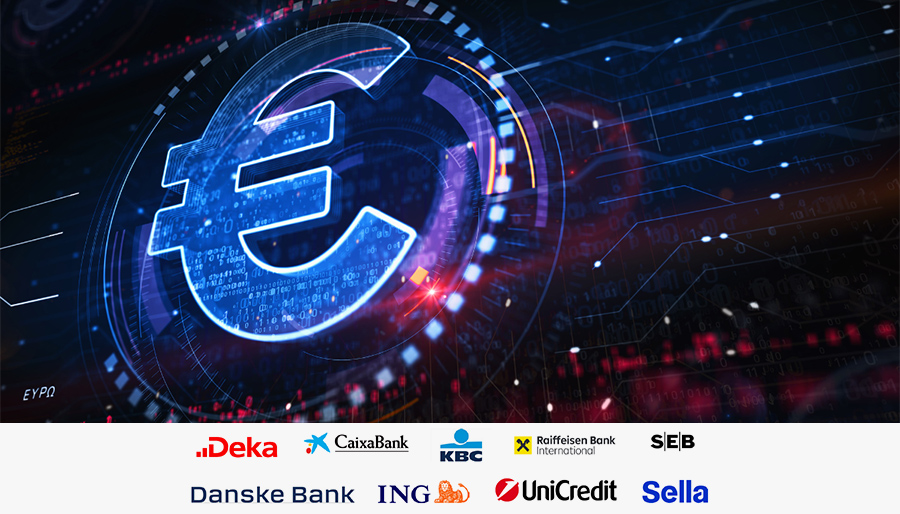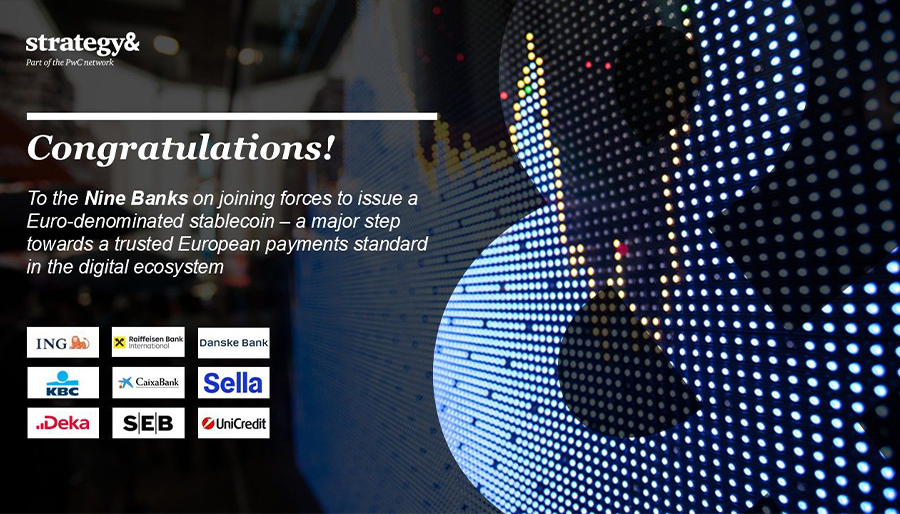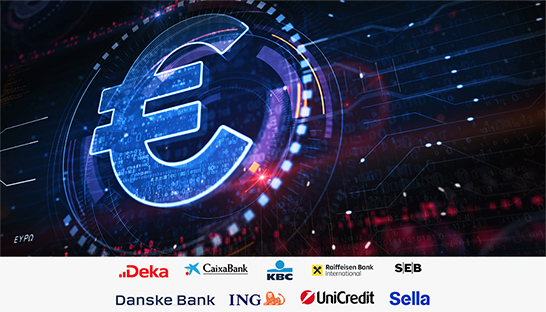
Nine major European banks have joined forces to develop a new euro-denominated stablecoin, in a move aimed at strengthening Europe’s position in the digital asset ecosystem and countering America’s market dominance. An international team from Strategy& and PwC supported the milestone project in Europe’s digital payments landscape.
Stablecoins are a type of cryptocurrency designed to offer price stability by pegging their value to an existing fiat currency – such as the dollar or euro – or to a commodity. This sets them apart from volatile cryptocurrencies like Bitcoin or Solana.
Today, the largest stablecoins are Tether (USDT), with a market capitalization of roughly $172 billion, and Circle’s USDC, valued at about $74 billion. Both are pegged to the US dollar. The euro market for stablecoins, by comparison, remains tiny. According to Bank of Italy data, euro-backed stablecoins total just $620 million, compared to nearly $300 billion in dollar-backed coins.
The new banking consortium aims to change that. “This initiative will provide a real European alternative to the US-dominated stablecoin market, contributing to Europe’s strategic autonomy in payments,” the banks said in a joint statement.
The consortium includes UniCredit (Italy), ING (Netherlands), Banca Sella (Italy), KBC (Belgium), Danske Bank (Denmark), Dekabank (Germany), SEB (Sweden), CaixaBank (Spain), and Raiffeisen (Austria).
Floris Lugt, Digital Assets Lead at ING and public representative of the initiative, commented: “Digital payments are key for new euro-denominated payments and financial market infrastructure. They offer significant efficiency and transparency, thanks to blockchain technology’s programmability features and 24/7 instant cross-currency settlement.”
“We believe this development requires an industry-wide approach, and it’s imperative that banks adopt the same standards.”
Ambition and challenges
The group’s ambition is to create a trusted European payment standard for the digital economy. Yet experts are divided on whether the initiative can succeed in a space long dominated by non-bank players.
The most successful stablecoins to date have been issued by private, non-bank entities. Attempts by banks have so far struggled to gain traction. For instance, Société Générale’s SG-FORGE launched a euro-based stablecoin in 2023, but it has seen limited adoption, with only €56.2 million in circulation, according to its website.
However, this new initiative carries significantly more weight. Together, the nine banks represent many of Europe’s largest economies and bring substantial assets and resources to the effort.
“This euro stablecoin will provide a real European alternative to the US-dominated stablecoin market.”
The case for stablecoins
The development comes amid continued European Central Bank (ECB) skepticism toward stablecoins. Speaking at an event in Amsterdam last month, ECB President Christine Lagarde warned that cryptocurrencies such as Bitcoin and privately issued stablecoins pose risks to monetary policy and financial stability.
As a safer alternative, she called for legislation to back the launch of a digital euro – a central bank digital currency issued directly by the ECB.
Supporters of stablecoins however argue they have a vital role to play in the evolving financial landscape. A recent Citi report projects that total global stablecoin issuance could reach $1.9 trillion by 2030 under its base-case scenario, and as much as $4 trillion in a more optimistic outlook.
The new euro stablecoin consortium aims to help Europe capture part of that growth. “Leveraging blockchain technology, the new stablecoin will provide near-instant, low-cost payments and settlements,” the consortium said. “It will enable 24/7 cross-border transactions, programmable payments, and greater efficiency in areas such as supply chain management and digital asset settlements.”
Consultants behind the project
The journey from concept to development was supported by consulting teams from Strategy& and PwC.
While few details have been released about their involvement, partner posts on LinkedIn indicate that Strategy& provided strategic, commercial and regulatory advisory on the business case and collaboration model.
PwC, meanwhile, contributed expertise in areas such as regulatory, compliance, risk management, financial crime, forensics, legal, and blockchain technology. The project team was led from the Netherlands, with specialists from Germany and the United States joining the engagement. Matt Blumenfeld, PwC’s Global Digital Assets Leader, was among those involved.

HQ in the Netherlands
The new Euro stablecoin will operate under the EU’s Markets in Crypto-Assets Regulation (MiCAR) framework and is expected to launch in the second half of 2026. The venture will be managed by a Netherlands-based company established by the consortium, which will be licensed and supervised by the Dutch Central Bank.
It is not known which consulting firms are helping the banks build the technical infrastructure and move the project forward to launch.
Meanwhile, over in the US, banks such as Bank of America and Citigroup are currently exploring the possibility of launching their own stablecoins.
